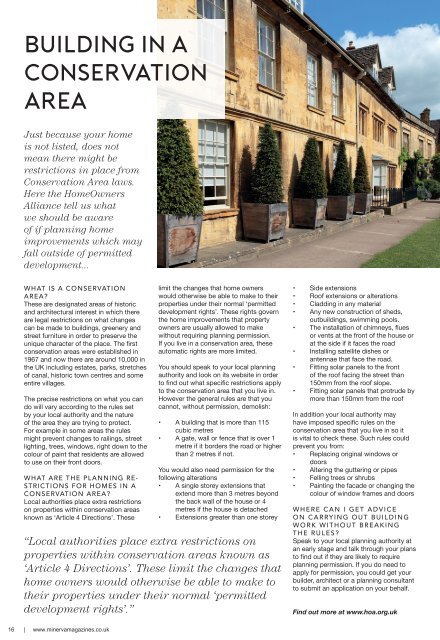Worthing Lifestyle May - Jun 2021
Summer is nearly upon us, so we have a bounty of great features, including lots of inspiration for the garden, fabulous recipes and a competition page with over £1500 worth of prizes to be won!
Summer is nearly upon us, so we have a bounty of great features, including lots of inspiration for the garden, fabulous recipes and a competition page with over £1500 worth of prizes to be won!
Create successful ePaper yourself
Turn your PDF publications into a flip-book with our unique Google optimized e-Paper software.
BUILDING IN A<br />
CONSERVATION<br />
AREA<br />
Just because your home<br />
is not listed, does not<br />
mean there might be<br />
restrictions in place from<br />
Conservation Area laws.<br />
Here the HomeOwners<br />
Alliance tell us what<br />
we should be aware<br />
of if planning home<br />
improvements which may<br />
fall outside of permitted<br />
development...<br />
WHAT IS A CONSERVATION<br />
AREA?<br />
These are designated areas of historic<br />
and architectural interest in which there<br />
are legal restrictions on what changes<br />
can be made to buildings, greenery and<br />
street furniture in order to preserve the<br />
unique character of the place. The first<br />
conservation areas were established in<br />
1967 and now there are around 10,000 in<br />
the UK including estates, parks, stretches<br />
of canal, historic town centres and some<br />
entire villages.<br />
The precise restrictions on what you can<br />
do will vary according to the rules set<br />
by your local authority and the nature<br />
of the area they are trying to protect.<br />
For example in some areas the rules<br />
might prevent changes to railings, street<br />
lighting, trees, windows, right down to the<br />
colour of paint that residents are allowed<br />
to use on their front doors.<br />
WHAT ARE THE PLANNING RE-<br />
STRICTIONS FOR HOMES IN A<br />
CONSERVATION AREA?<br />
Local authorities place extra restrictions<br />
on properties within conservation areas<br />
known as ‘Article 4 Directions’. These<br />
limit the changes that home owners<br />
would otherwise be able to make to their<br />
properties under their normal ‘permitted<br />
development rights’. These rights govern<br />
the home improvements that property<br />
owners are usually allowed to make<br />
without requiring planning permission.<br />
If you live in a conservation area, these<br />
automatic rights are more limited.<br />
You should speak to your local planning<br />
authority and look on its website in order<br />
to find out what specific restrictions apply<br />
to the conservation area that you live in.<br />
However the general rules are that you<br />
cannot, without permission, demolish:<br />
• A building that is more than 115<br />
cubic metres<br />
• A gate, wall or fence that is over 1<br />
metre if it borders the road or higher<br />
than 2 metres if not.<br />
You would also need permission for the<br />
following alterations<br />
• A single storey extensions that<br />
extend more than 3 metres beyond<br />
the back wall of the house or 4<br />
metres if the house is detached<br />
• Extensions greater than one storey<br />
“Local authorities place extra restrictions on<br />
properties within conservation areas known as<br />
‘Article 4 Directions’. These limit the changes that<br />
home owners would otherwise be able to make to<br />
their properties under their normal ‘permitted<br />
development rights’.”<br />
• Side extensions<br />
• Roof extensions or alterations<br />
• Cladding in any material<br />
• Any new construction of sheds,<br />
outbuildings, swimming pools.<br />
• The installation of chimneys, flues<br />
or vents at the front of the house or<br />
at the side if it faces the road<br />
• Installing satellite dishes or<br />
antennae that face the road.<br />
• Fitting solar panels to the front<br />
of the roof facing the street than<br />
150mm from the roof slope.<br />
• Fitting solar panels that protrude by<br />
more than 150mm from the roof<br />
In addition your local authority may<br />
have imposed specific rules on the<br />
conservation area that you live in so it<br />
is vital to check these. Such rules could<br />
prevent you from:<br />
• Replacing original windows or<br />
doors<br />
• Altering the guttering or pipes<br />
• Felling trees or shrubs<br />
• Painting the facade or changing the<br />
colour of window frames and doors<br />
WHERE CAN I GET ADVICE<br />
ON CARRYING OUT BUILDING<br />
WORK WITHOUT BREAKING<br />
THE RULES?<br />
Speak to your local planning authority at<br />
an early stage and talk through your plans<br />
to find out if they are likely to require<br />
planning permission. If you do need to<br />
apply for permission, you could get your<br />
builder, architect or a planning consultant<br />
to submit an application on your behalf.<br />
Find out more at www.hoa.org.uk<br />
16 | www.minervamagazines.co.uk


















